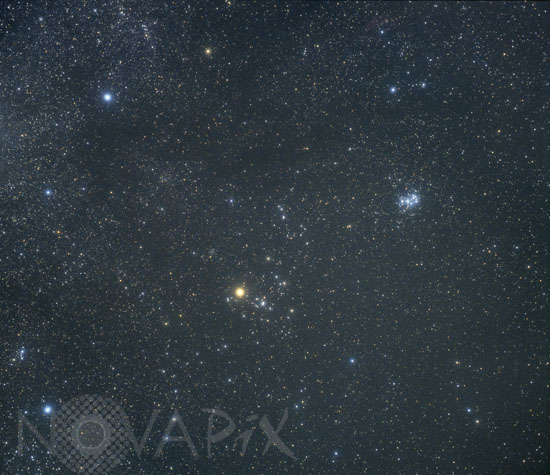Photo Agency - Astronomy - Space - Nature

Constellation of Taurus
author: A.Fujii/David Malin Images/Novapix
reference: a-cst81-00001
Image Size 300 DPI: 47 * 40 cm
Taurus, (the Bull) is one of the most ancient constellations, and appears in artefacts as old as western civilisation itself. The bull is still a figure of strength and fertility in cultures around the world. In the sky the distinctive 'V' shape of his head and long horns tipped by beta (ß) and zeta Tau is easily recognised. If the purpose of the horns was in doubt, the Arabic name for ß Tau is Alnath, meaning 'the butting one'. The bull's glowing red eye of Aldebaran completes the picture, and its location between the delicate Pleiades and the aggressive stance of Orion makes Taurus hard to overlook. Despite its masculine connotations, the constellation is rich in female icons; both the Hyades and Pleiades star clusters are daughters of Atlas and both are important astronomically. The Pleiades (or the Seven Sisters) are a group of young stars at a distance of about 440 light years and on long exposure photographs are seen to be embedded in dust which reflects their light as a blue haze. The Hyades is much closer, and at 150 light years distant is the nearest open cluster to the Sun. However the bright star Aldebaran is much closer (65 ly) and is a chance alignment. Without it there would be no bull in Taurus. Probably the most interesting object in Taurus is M1, the Crab nebula, the remains of a star that exploded in the year 1054BCE.
Â
Keywords for this photo:
ALDEBARAN - ASTRONOMY - CONSTELLATION - HYADES - M45 - NIGHT - OPEN CLUSTER - PLEIADES - POSTER - RED GIANT - STAR - STAR CLUSTER - STARRY SKY - TAURUS - ZODIAC -
Contact : Stéphane Aubin +33-(0)9-51-26-53-76
© Novapix - All rights reserved


